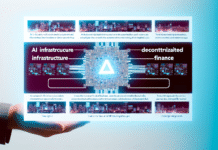Key takeaways
- Loot is the latest project to take the NFT world by storm.
- It is listed at a floor price of 7.5 ETH on OpenSea as of now.
- Through a bottom-up approach, Loot kindles a new era of the metaverse.
Dom Hofmann has some paradigm-shifting projects under his belt. From Vine to Bitmap, his out-of-the-box thinking continues to inspire. So when he dropped in cues about his upcoming project, a text-based game similar to Dungeons and Dragons, Twitter was hooked.
text-based fantasy cryptoloot
use ur imagination to play
and maybe a smart contractdungeons & degens
— dom (@dhof) August 25, 2021
The word about the project spread soon. At the time of writing, the trading volume stands at a whopping 64.2K ETH. Loot has its share of derivatives, imitators, and spoofs too, which are also surprisingly doing well in the market. Bloot is a great example.
If you have been wondering what this hoo-ha is all about and whether you are missing out on something, let us catch you up. Here is everything you need to know about Loot. And why it matters.
What is Loot NFT?
At its core, Loot (for Adventurers) is a collection of tokenized lists. There are 8000 Loot bags in total with 8 randomized fantasy gear from a fictional world spelled out. During the launch, anybody could mint them from the smart contract for free by paying the gas fees. They were sold out just a few hours into going live. After that, the NFTs were listed on OpenSea.
At first sight, they are just white texts on a black background that make little sense. Take this Loot bag for an example:
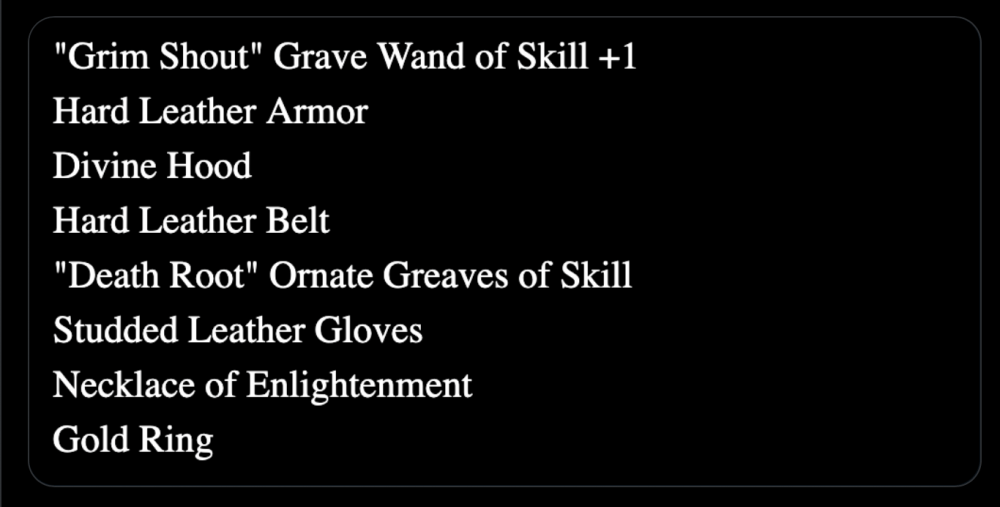
Unlike most NFTs, Loot is not accompanied by artwork, games, or stats. The lists are open for interpretation and exploration. Barebones for something big to come, we assume. It is upon the community now to take over the project and make it what it is.
Still confused, explain
Each item in a Loot bag can be loosely compared to the building blocks in Lego. The player determines what the structure looks like using her creativity and innovation. Likewise, the items listed on Loot bags have no predefined utilities or purposes. However, the Loot community can give them different purposes on multiple platforms as they find relevant. Projects can be built based on the items listed, or existing projects can be tweaked to integrate them.
According to the official website, Loot is the ‘unfiltered, uncensorable building block for stories, experiences, games, and more in the hand of the community, at no cost’.
Let’s say a fantasy metaverse where the ‘Necklace of Enlightenment’ gives you the edge in a hot debate hosted by the King. Or, the ‘Gold Ring’ blesses you with the Midas touch. Or, the ‘Divine Hood’ turns you invisible from your enemies. Imagination draws the limits.
More Loots
One of the major criticisms against Loot was that it didn’t have a community large enough to build an ecosystem around it. What is the most a group of 8000 holders (or less) can do? A gaming platform needs gaming enthusiasts. However, there is no way of telling if the existing holders are in fact gamers. They could be just ordinary office-going people with little to no time to spare for the platform.
This is what sparked the creation of More Loot, an extension of the original collection. There are 1,308,004 More Loots, granting more people access to the ecosystem. The supply doesn’t have a hard cap.
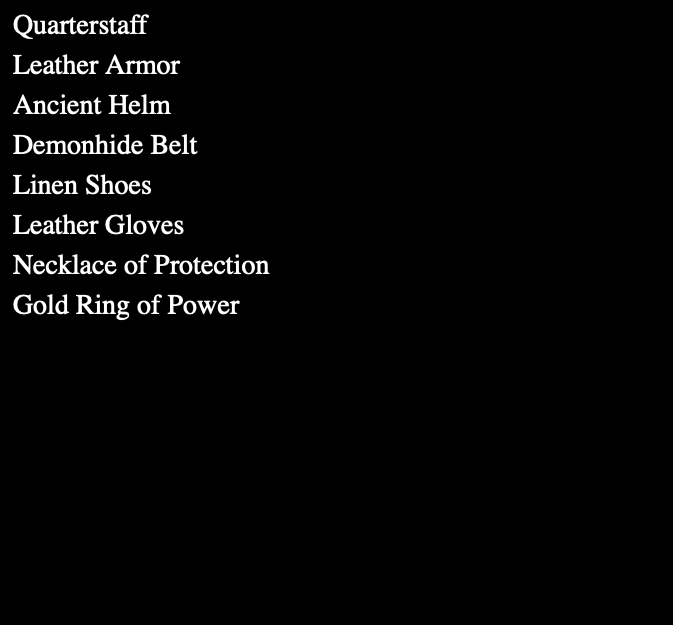
More Loot is similar to the original collection in many aspects. White texts are written against a black background. Each bag has a list of eight attributes that determine the rarity of the NFT. And more importantly, it has a similar pool of traits. As expected, the floor price of More Loot is much lower when compared to Loot. The current floor price is less than 0.01 ETH owing to the large number of tokens in circulation. More than 157 ETH has been traded so far.
Loot derivatives
If you have heard about Loot, you must have heard about Loot derivatives too. They are projects built on top of Loot that play a key role in driving the growth of the ecosystem. Since Loot is essentially community-driven, it promotes the creation of replicas with an interesting take. The ultimate aim is to inspire more people to onboard the ecosystem where they can share ideas and build the gaming platform together.
Currently, there are more than 70 Loot derivatives listed on the official website. One of the most popular examples is Adventure Gold or $AGLD token, which was given away to Loot holders for free. We will discuss that in detail in a later section. Each project is built on the foundation laid by Loot and adds to its fun and utility.
For example, Color Loot is a derivative that provides Loot rarity data on-chain. Deck of Many Things is a 22 card game inspired by Loot. Dungeons (for Adventures) rolls out on-chain generative rogue-style dungeons for Loot. Loot Descriptions gives AI-generated role-playing descriptions based on the project. Loot Dungeon is another D&D-inspired game that lets Loot owners fight monsters and earn rewards. The list goes on, but you get the drift.
Derivatives could be another game, art, story, or music project. Since they are submitted by the community and not yet audited, the website warns us to exercise caution while using them.
Synth Loot
Synthetic Loot NFTs were launched shortly after Loots caught attention. Since the original collection was limited to just 8000 pieces, it didn’t give many the chance to join the hype.
Synthetic Loot
– returns a "virtual nft" of loot based on a given wallet
– b/c the wallet is the seed, only one bag per wallet
– because it's not a "real" nft, no minting, transferring, selling, etcanyone with an ethereum wallet has synthetic loothttps://t.co/K2fx9Zw7qQ
— dom (@dhof) September 1, 2021
With Synth Loot, you too can generate your own Loot NFT as long as you have an Ethereum wallet. It is definitely not a part of the original collection. However, it can be a part of Loot derivative projects depending on how the developers feel about it.
The most exciting part about Synth Loot is that it doesn’t have to be minted. All wallets come with it. It is generated based on the Ethereum wallet address rather than a numeric identifier. Since the supply of Synth Loot will always be equal to the number of Ethereum wallets, it is deemed to be forward compatible.
$AGLD (Adventure Gold) tokens
Since launching, many projects have come forward to reward Loot holders and tap into the value generated. However, none has matched the hype created by Adventure Gold. It is basically a decentralized autonomous organization (DAO) dedicated to Loot owners.
Adventure Gold was launched on 2 September 2021. It came into circulation by allowing each Loot owner to claim 10,000 tokens for free. Moreover, there aren’t any reserved tokens for the creator. As of now, the price of $AGLD stands at $2.97. At one point, it had gone up as high as $7.16.
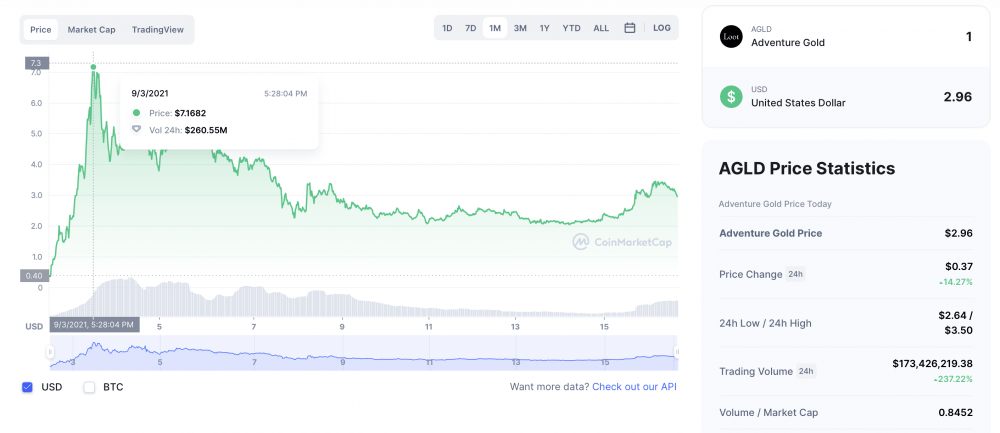
Will Papper, the cofounder of Syndicate DAO is the creator of $AGLD. He says he wanted to do this for the Loot community and set a standard for projects that build on Loot in the future.
Similar to Loot NFTs, the community decides the utility of $AGLD tokens. They can be primarily used for governance, to earn future in-game credits, or facilitate mints. There will be more opportunities to claim $AGLD in the future depending on where the community stands. If the votes are in favor of new seasons, the contract allows for new claims of $AGLD. Also, it can be minted for the Loot DAO treasury or ecosystem. At the end of the day, the community decides its role in the Loot ecosystem.
If the trend picks up, Adventure Gold will play an integral role in fueling the Loot economy.
What is Bloot?
Bloot (not for the Weaks) is a spoof of Loot, but with all the right intentions. It came with a modest tagline too — ‘It’s basically worthless’. However, Bloot is currently selling at a floor price of 0.28 ETH and has a trading volume of 8.5K ETH.
The project was launched soon after Loot came into the limelight. Set against a neon green background, it is definitely an eye-catchy dupe. Even if the color fails to catch your attention for some reason, the texts won’t.
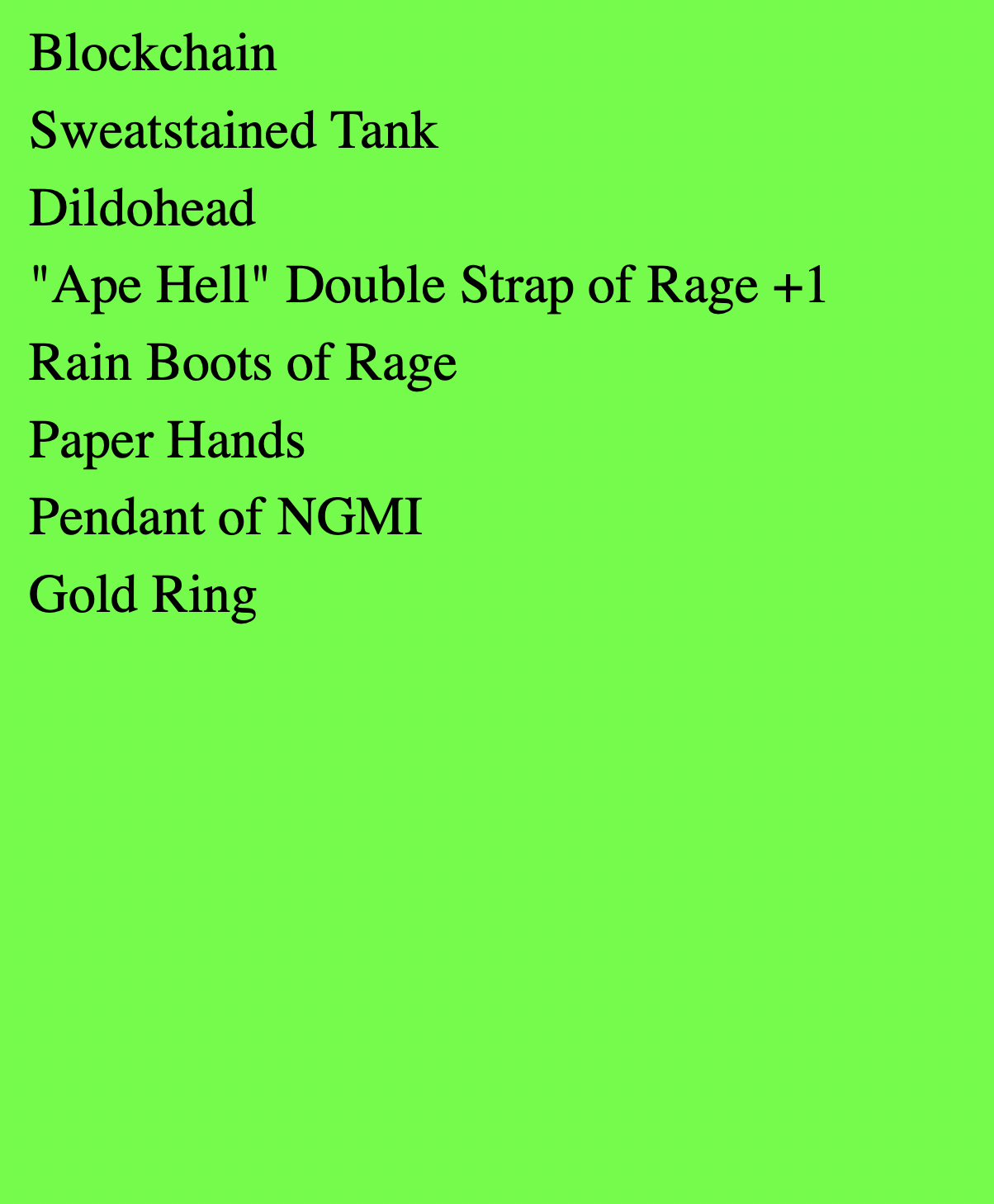
Boots comes from Pixel Vault investor and advisor Beanie and team. He confirms that the project was inspired by Loot and there is no truth to the rumor about an ongoing rivalry between the two projects. In the crypto ecosystem, support and collaboration are key to success. Together, multiple projects can climb new heights. That explains the hype around Loot, Bloot, and other derivatives.
There's no "war with Loot". I have lots of respect for @dhof the Loot dev. He's spoken on my Twitter Spaces before. Bloot is inspired by Loot. We're planning to talk this week to share ideas. Looking forward to building. We can all succeed. Even the VCs. No need for dirty tricks.
— Beanie (@beaniemaxi) September 6, 2021
Bloot holders were rewarded with 10,000 $BGLD tokens that hit the highest mark at $1.14 on 6 Sep 2021. That is, if you had invested a small amount in Bloot tokens during the launch, despite knowing they are ‘basically worthless’, it would have earned you more than $10,000 in just a day. Feeling FOMO? Don’t worry, $BGLD tokens are selling at $0.16 now.
Many have raised eyebrows on the sustainability of giving away NFTs for free. To add to that, there are future airdrops. Is it just another pump-and-dump business model with no prospect of surviving in the long run?
“You simply own a Bloot and you get free drops. This business model is sustainable as long as Bloot keeps selling in the market and earning royalties for the team,” says Beanie. According to his latest tweets, $BGLD tokens will be integrated into his existing and upcoming projects. They will facilitate payments, act as lending collateral, and earn other NFTs.
Spoof or not, Bloot has the potential to pave the way for a community-built metaverse, staying true to the decentralized spirit of blockchain and NFTs. Much like Loot, Bloot has witnessed an outpour of enthusiasm from across the crypto community since its launch. Multiple projects and tokens were spawned around Bloot in the following days, fueling the hype.
“48 hours into Bloot, I’ve seen dozens of projects built off it already. Most of them free claims for Bloot and $BGLD holders,” Beanie tweeted.
Shockingly, Bloot has spoofs too! Take a look.
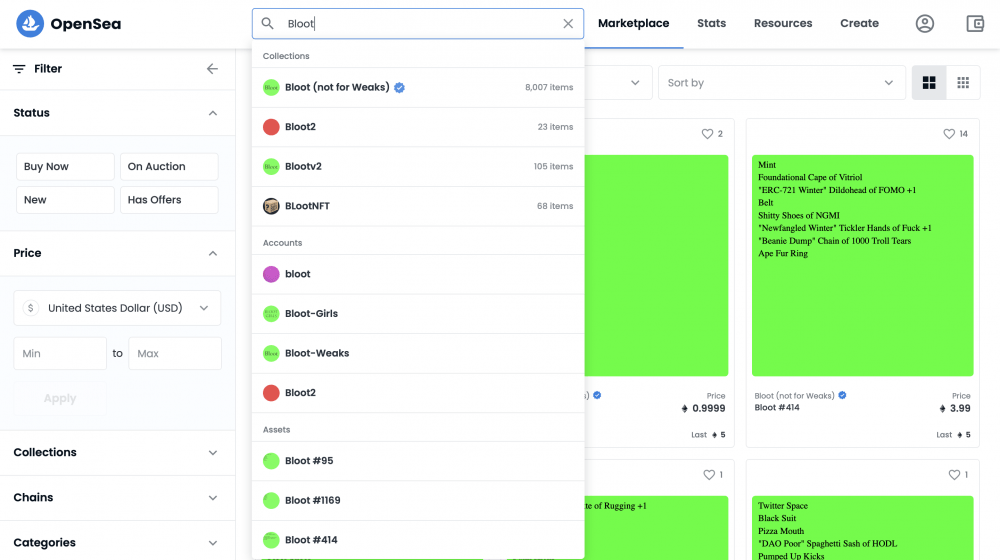
How does Loot mark a new milestone in the NFT revolution?
Blockchain technology has overhauled the collectible industry inside out. NFTs imparted scarcity and rarity to digital assets, they are selling like hotcakes today.
While the sphere was mostly dominated by profile picture projects like Crypto Punks in the initial stages, more platforms with fun and unique utilities have come to the forefront recently. NFTs are venturing into sectors that have for long been reserved under centralized authorities, with a new definition of asset ownership and transfer.
However, they all have something in common — an underlying purpose. A robust set of use cases that give value to the NFTs. A team of creators who build the project, tokenize the assets, and hand them over to users as a means to incite engagement on the platform. That was how things have been done. And, it was moving forward without any hassles.
But then, a weird idea popped in Dom Hofmann’s head. Why do we always have to do things the way they are? Why don’t we flip the script!
Loot stirs up interesting debates with a bottom-up approach to building an NFT ecosystem. Here is what that means.
Bottom-up approach
As you can see from the image below, a predefined group of developers, designers, and artists create NFT platforms. After launching the NFTs, they conduct competitions, events, and airdrops to create buzz around the project. Funds from the sale of the NFTs or royalties are used to further expand the project under the leadership of the team.
Can you call it completely decentralized though?
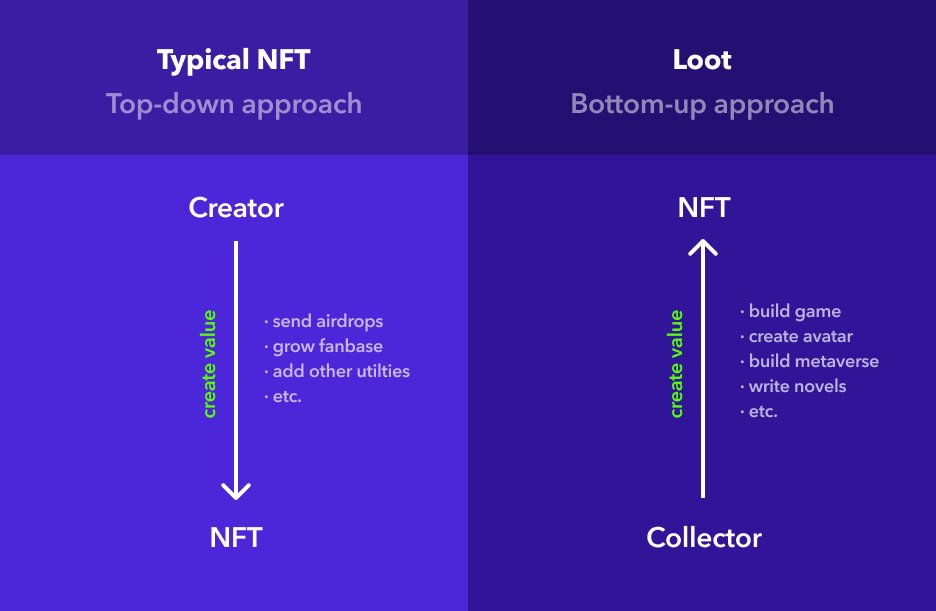
When it comes to bottom-up projects like Loot, the business model is inherently decentralized. Here, the NFTs are launched first without any underlying project. The community can spin stories around the listed items in the Loot bag, get their creative juices flowing and manifest avatars, give utility to the NFTs on multiple platforms, and build an interoperable Loot metaverse. It ignites the imagination of the community and incentivizes them to create the platform. A truly decentralized platform in vision and implementation that derives value from the community rather than the creator, inverting the existing NFT business models.
The fundamental idea is similar to Ethereum. When Ethereum was launched, it was just a primitive blockchain technology with its own set of limitations. It offered some basic tools that empowered developers to build around Ethereum and create value. Ethereum got it right by handing over the responsibility of development and growth to the community. This is the same principle followed by Loot. It has given out some bare-bones. It is now on us to pick them up and develop a first-of-its-kind community-owned gaming platform.
“When Dom Hofmann created Loot it’s like he created the 6-sided dice or the 52-card playing deck. There will be myriad games built on top that everyone can play and no one owns. I believe there will even be multiple universes and stories with their own canon, not just one,” opines Avichal Garg, the Founder of ElectricCapital. He also believes that Loot is the third major NFT breakthrough after how Crypto Punks revolutionized collectibles and Art Blocks brought generative art to the fore.
Is Loot here to stay?
It is too early to say.
We don’t know yet if the contract is foolproof. There is still room for hacks, attacks, and design flaws. The credibility of the upcoming projects around Loot is also questionable. It will have to go through the inevitable troughs and crests of the market in the long run.
However, from the recent trends, it is evident that the item-before-game approach introduced by Loot has inspired many to rethink their business strategy. The lack of interoperability that has been plaguing the blockchain industry since its inception will be solved to a great extent in the gamified metaverse. It empowers holders to hop from one platform to another and use their gaming assets seamlessly.
Even though the concept is yet to be validated, it rekindles the decentralized vision of blockchain technology and NFTs. If it unfolds the way we intend, gaming as we know it will be pushed back into a bygone era.





